
Advertisement
Advertisement
Advertisement
Voting on an Arizona reservation: “We are different.”
 Rebekah T. Ello-Lewis, a Pascua Yaqui member, rides the bus from her reservation to vote in Tucson, Arizona. Cassandra Giraldo for VICE News.
The #29 bus runs every 30 minutes from the station stop outside of the Casino of the Sun, the smaller of the two casinos located on the Pascua Yaqui Native American reservation. A small sign taped to the station bench reads “CAST YOUR BALLOT EARLY!”
Rebekah T. Ello-Lewis, an assistant for voter outreach, didn’t expect anyone to travel off the reservation to vote early, but she wanted to know what the eight-mile journey on public transportation entailed. The 29-year-old Pascua Yaqui mother catches the first of two buses around 11 a.m. and rides for half an hour, winding through flat desert roads. She transfers at the Laos Transit Center and pays the fare again, riding for another 30 minutes before reaching the Mission Library. It takes her less than two minutes to cast her ballot; the one-way trip took about an hour.
Since 2010, the Pascua Yaqui had hosted an early voting site on the reservation, a three-square-mile plot of land about 15 miles outside of downtown Tucson, Arizona. But about a month before Arizona’s August primary election, the Pima County recorder’s office informed tribal leaders that they were moving one of the city’s 11 early voting locations off the reservation.
Rebekah T. Ello-Lewis, a Pascua Yaqui member, rides the bus from her reservation to vote in Tucson, Arizona. Cassandra Giraldo for VICE News.
The #29 bus runs every 30 minutes from the station stop outside of the Casino of the Sun, the smaller of the two casinos located on the Pascua Yaqui Native American reservation. A small sign taped to the station bench reads “CAST YOUR BALLOT EARLY!”
Rebekah T. Ello-Lewis, an assistant for voter outreach, didn’t expect anyone to travel off the reservation to vote early, but she wanted to know what the eight-mile journey on public transportation entailed. The 29-year-old Pascua Yaqui mother catches the first of two buses around 11 a.m. and rides for half an hour, winding through flat desert roads. She transfers at the Laos Transit Center and pays the fare again, riding for another 30 minutes before reaching the Mission Library. It takes her less than two minutes to cast her ballot; the one-way trip took about an hour.
Since 2010, the Pascua Yaqui had hosted an early voting site on the reservation, a three-square-mile plot of land about 15 miles outside of downtown Tucson, Arizona. But about a month before Arizona’s August primary election, the Pima County recorder’s office informed tribal leaders that they were moving one of the city’s 11 early voting locations off the reservation.
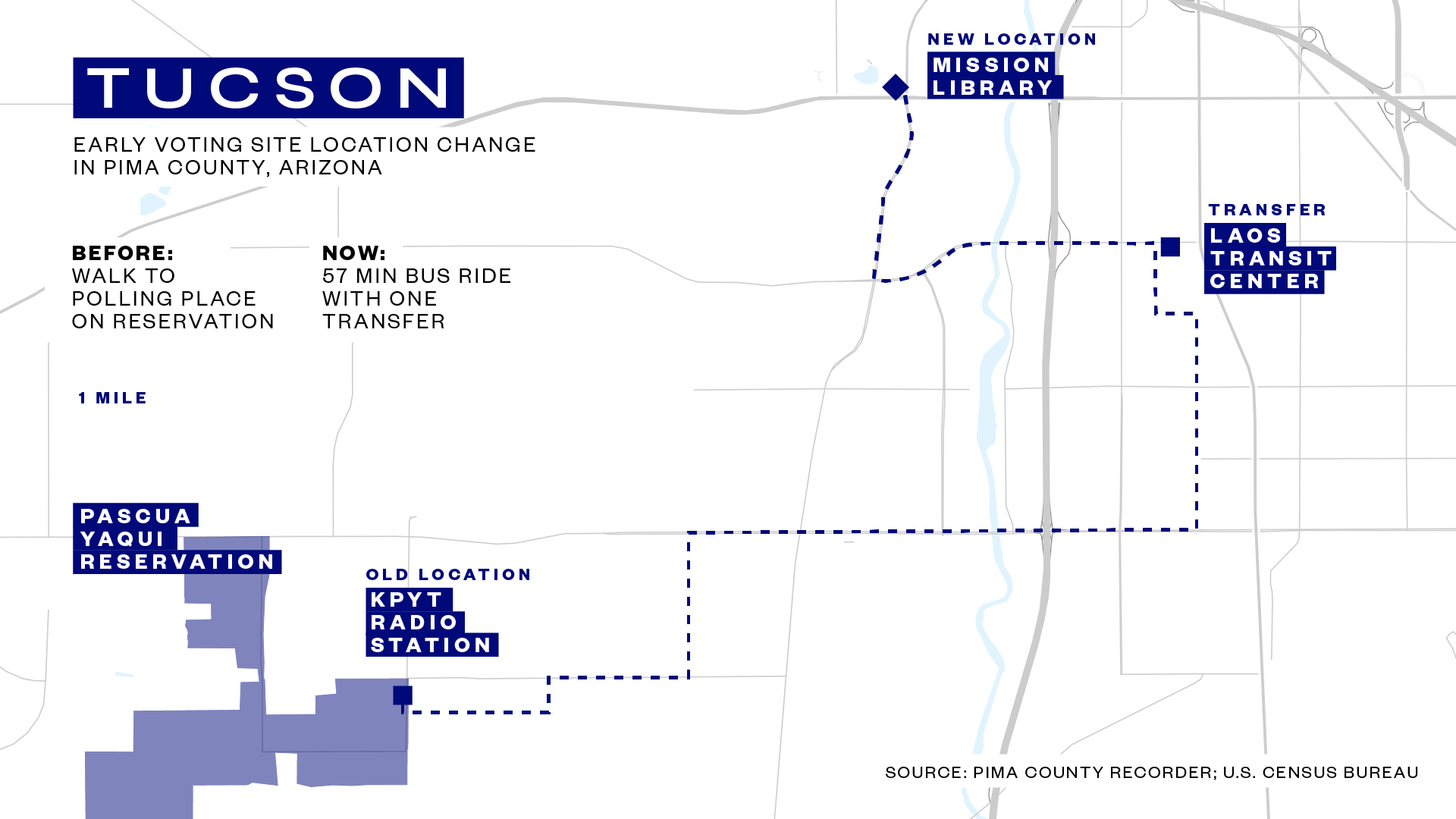 F. Ann Rodriguez, the Pima County recorder, cited low turnout figures as the reason behind her decision to close the polling station. She said only 44 voters cast a ballot on the reservation during the five days of early voting in 2016, compared with nearly 10,000 voters in the precinct who cast a ballot by mail (these figures include both tribal and nontribal voters).
“They [the Pascua Yaqui] just don't like to go to the early voting site. They like to vote by mail, or they're traditionalists,” Rodriguez said, implying that tribal members prefer to vote on Election Day. Tribal leaders, however, argue that their recent efforts to increase voter turnout were not taken into consideration. In March, they launched “Yaqui Vote,” holding more than 40 voter outreach and registration events this year.
F. Ann Rodriguez, the Pima County recorder, cited low turnout figures as the reason behind her decision to close the polling station. She said only 44 voters cast a ballot on the reservation during the five days of early voting in 2016, compared with nearly 10,000 voters in the precinct who cast a ballot by mail (these figures include both tribal and nontribal voters).
“They [the Pascua Yaqui] just don't like to go to the early voting site. They like to vote by mail, or they're traditionalists,” Rodriguez said, implying that tribal members prefer to vote on Election Day. Tribal leaders, however, argue that their recent efforts to increase voter turnout were not taken into consideration. In March, they launched “Yaqui Vote,” holding more than 40 voter outreach and registration events this year.
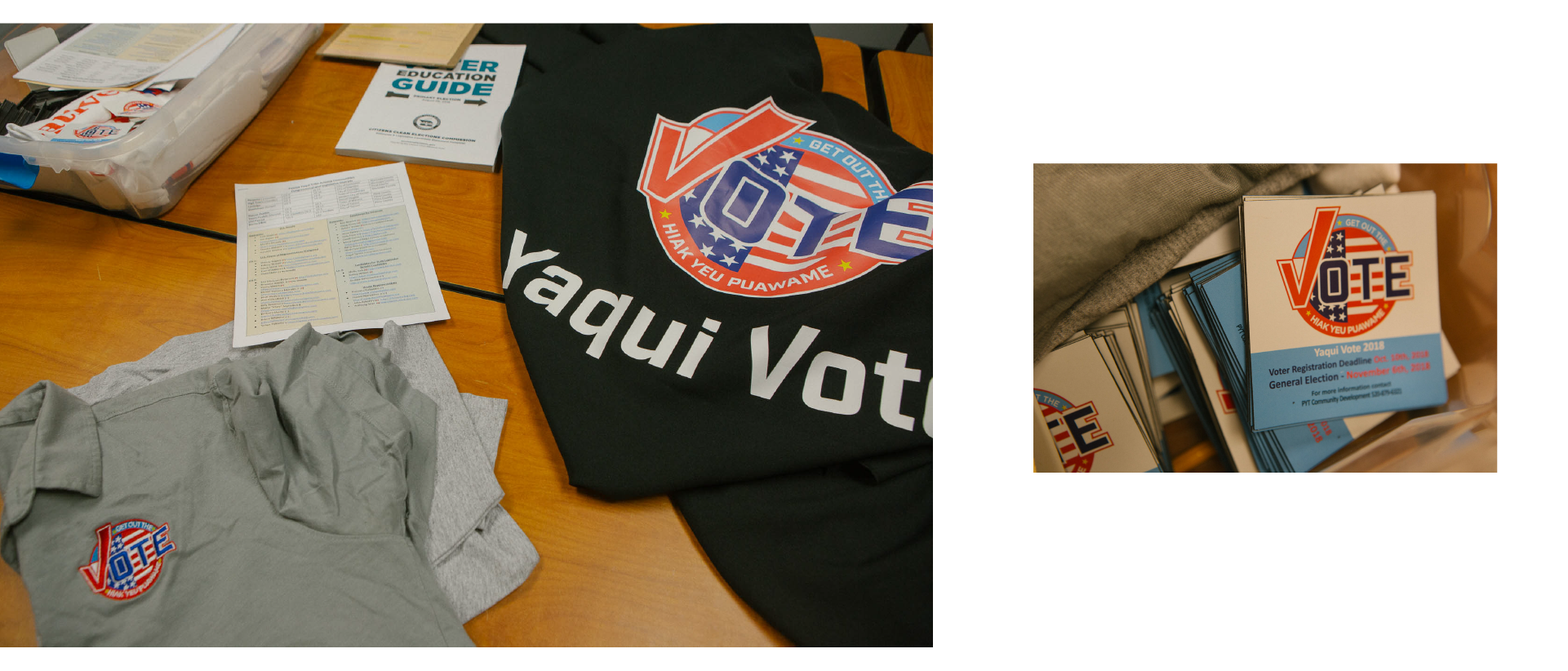 Yaqui Vote campaign materials. Cassandra Giraldo for VICE News.
“We've been working so hard, and then for them to tell us this — for her to say it’s not enough — it was kind of like they just knocked everything out from underneath us,” said Letticia Baltazar, the tribe’s director of voter outreach.
The Pascua Yaqui still have a polling place available on Election Day, but tribal leaders feel the removal of the early voting site wasn’t done with a commensurate effort to encourage alternate methods of voting.
Yaqui Vote campaign materials. Cassandra Giraldo for VICE News.
“We've been working so hard, and then for them to tell us this — for her to say it’s not enough — it was kind of like they just knocked everything out from underneath us,” said Letticia Baltazar, the tribe’s director of voter outreach.
The Pascua Yaqui still have a polling place available on Election Day, but tribal leaders feel the removal of the early voting site wasn’t done with a commensurate effort to encourage alternate methods of voting.
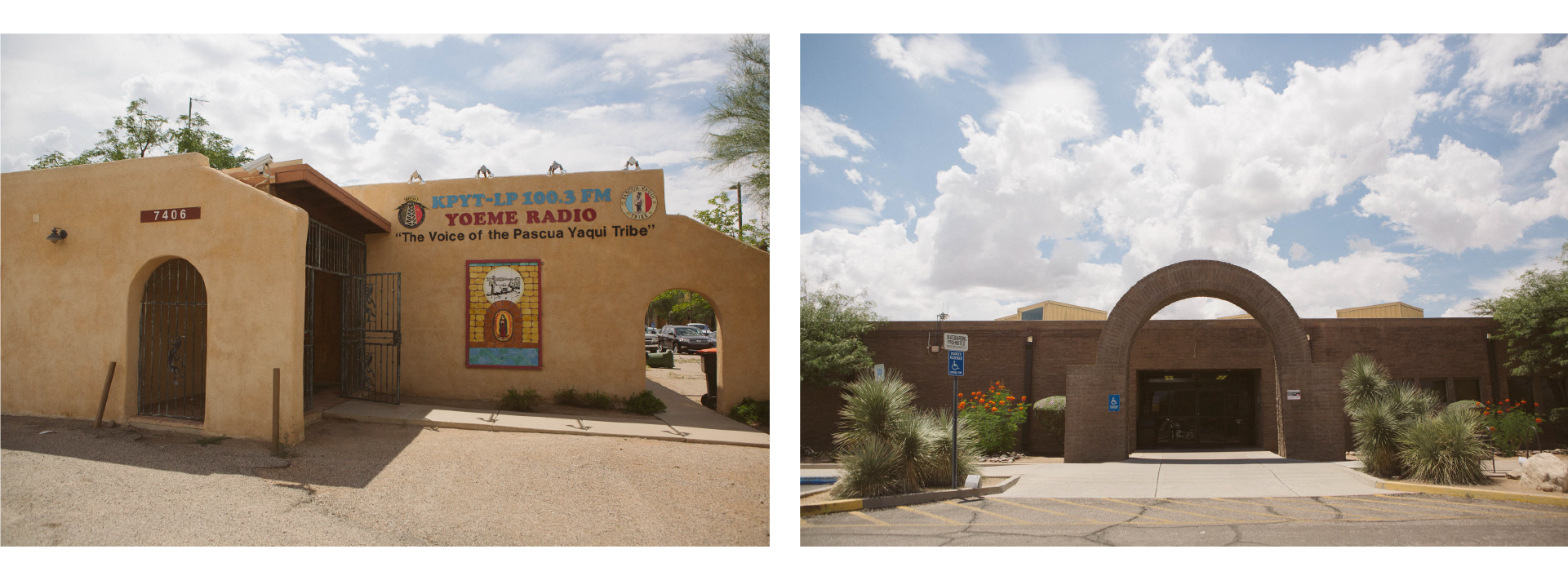 Left: The former early voting site on the Pascua Yaqui reservation. Right: The new early voting site at the Mission Library. Cassandra Giraldo for VICE News.
“I know Pima County is really counting on mail-in ballots, but then they have to put some effort into educating people about how to do that,” said Herminia Frias, a Pascua Yaqui council member. Frias said many Yaqui voters either don’t know they can vote by mail or are unfamiliar with the process of requesting a mail ballot.
Between the 2012 and 2016 general elections, Pima County closed 15 percent of its Election Day polling locations, a drop that county officials largely attribute to the rise in early voting. About 70 percent of Pima County voters now cast a ballot early, either by mail or at an early voting site.
Left: The former early voting site on the Pascua Yaqui reservation. Right: The new early voting site at the Mission Library. Cassandra Giraldo for VICE News.
“I know Pima County is really counting on mail-in ballots, but then they have to put some effort into educating people about how to do that,” said Herminia Frias, a Pascua Yaqui council member. Frias said many Yaqui voters either don’t know they can vote by mail or are unfamiliar with the process of requesting a mail ballot.
Between the 2012 and 2016 general elections, Pima County closed 15 percent of its Election Day polling locations, a drop that county officials largely attribute to the rise in early voting. About 70 percent of Pima County voters now cast a ballot early, either by mail or at an early voting site.
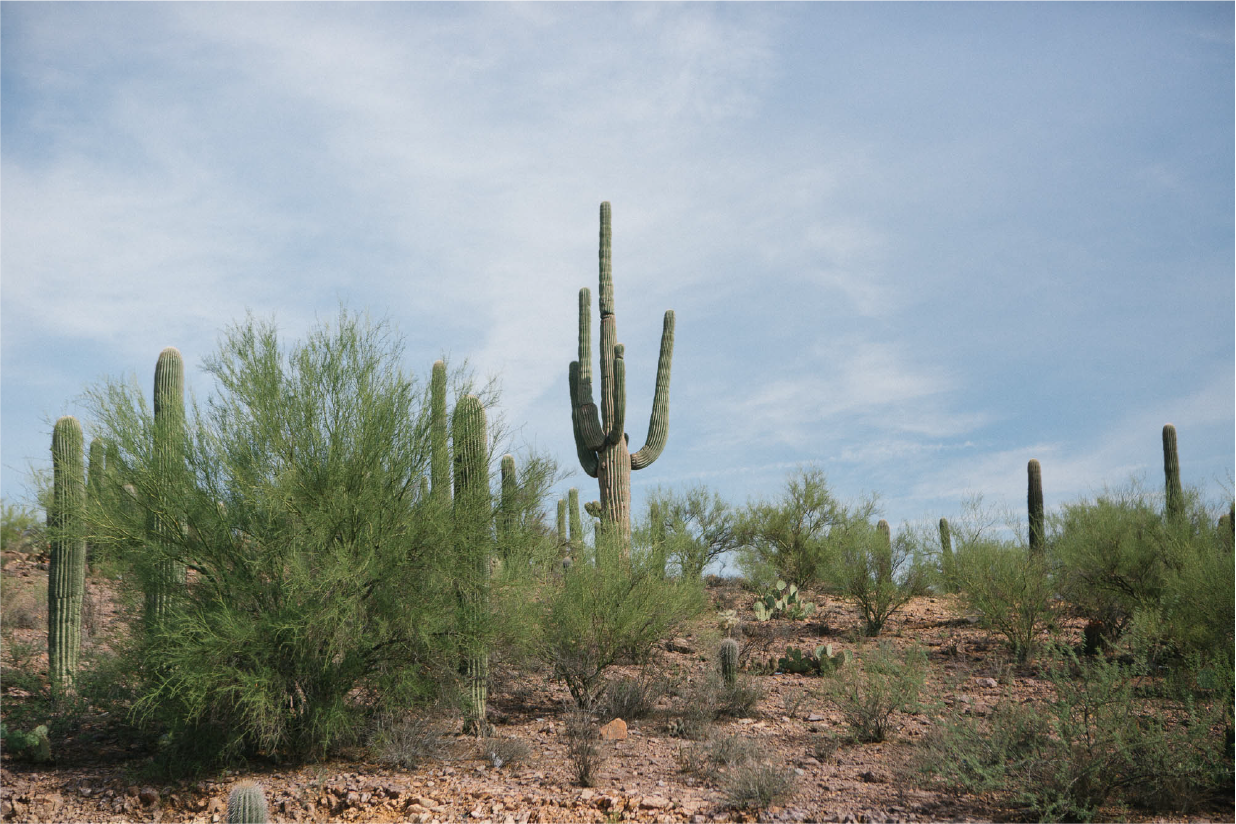 Cassandra Giraldo for VICE News.
Robert Valencia, the chairman of the tribe, said the decision by the recorder’s office felt reminiscent of when Native American voting rights were limited — they weren’t granted full U.S. citizenship until 1924, and in Arizona Native Americans weren’t able to vote until 1948.
“The movement from the recorder's office has been vote by mail. And that's worked for Tucson in general, and so I think they see the reservation as no different,” said Frias. “But it is different. We are different.”
Cassandra Giraldo for VICE News.
Robert Valencia, the chairman of the tribe, said the decision by the recorder’s office felt reminiscent of when Native American voting rights were limited — they weren’t granted full U.S. citizenship until 1924, and in Arizona Native Americans weren’t able to vote until 1948.
“The movement from the recorder's office has been vote by mail. And that's worked for Tucson in general, and so I think they see the reservation as no different,” said Frias. “But it is different. We are different.”
The data
Advertisement
Advertisement
Advertisement
Backlash in Georgia: “What is the price of our democracy?”
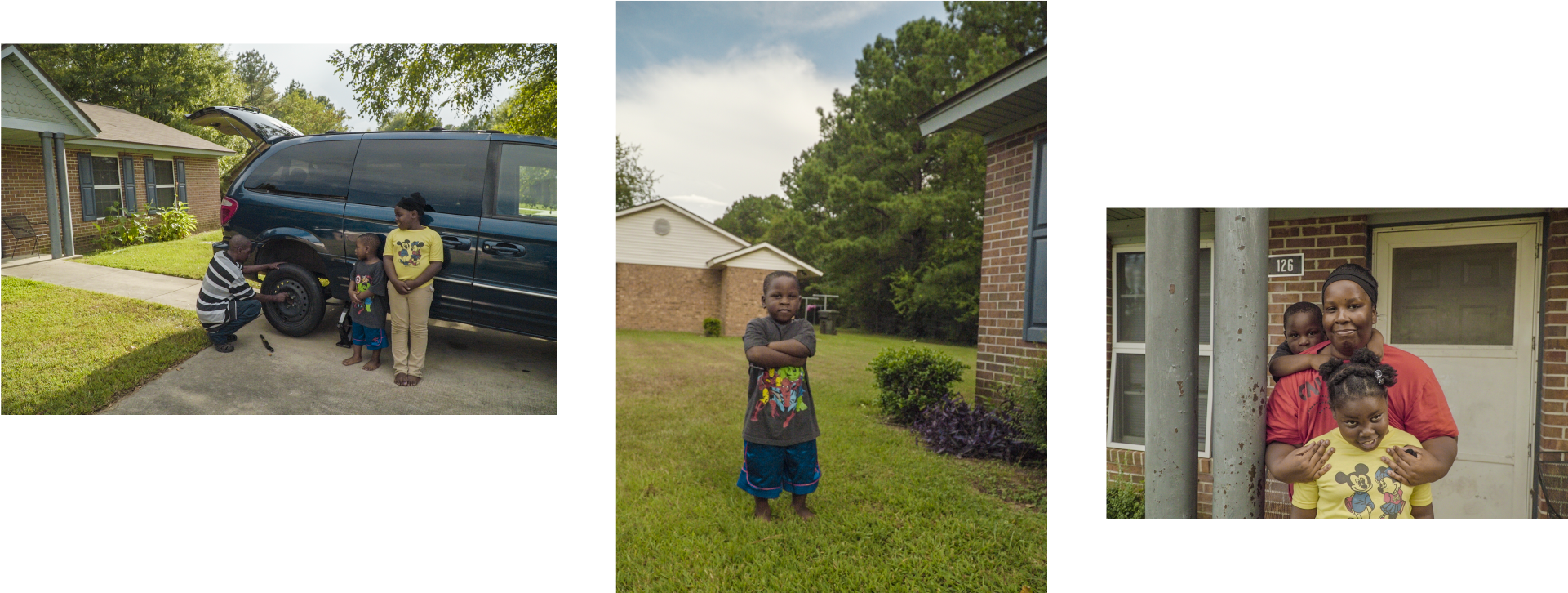 The Carswell family at home in Macon, Georgia. Allison McCann for VICE News.
In August, lawyers from the ACLU of Georgia were alerted to a proposal to close seven of nine polling places in the rural, predominantly black Randolph County. The county’s board of elections said the advice to cut almost 80 percent of poll locations came from an outside consultant, Michael Malone, who argued that the sites were not compliant with the Americans with Disabilities Act (though no reports or documents supported this assertion.)
The ACLU of Georgia threatened legal action, and after two heated public meetings, the board voted 2-0 against the closures. Randolph County also fired Malone. “We heard about Randolph County and we were able to stop them [from closing the polls], but there are 159 counties in Georgia,” said Sean Young, the legal director of the ACLU of Georgia.
Three years earlier, in nearby Macon-Bibb County, civil rights organizations weren’t as successful. In 2012, Bibb County had 40 polling places. Two years later, the county merged with the city of Macon, and in the process, “all departments were asked to cut their budgets,” said elections officer Tom Gillon. In 2015, the newly formed Macon-Bibb County Board of Elections proposed reducing the number of polling places to 26, stating that the closures would save them around $40,000 annually.
The local NAACP quickly intervened, and an advisory panel was formed to reconsider the closures. “All of the places where they were proposing to close polls were within neighborhoods of low-income or majority black people,” said Gwen Westbrooks, the president of the Macon-Bibb NAACP chapter.
The board ultimately decided to close eight locations that year, and another the following. Macon-Bibb County now has 31 polling places for nearly 100,000 registered voters, about 30 percent more voters per polling place than the national average.
The Carswell family at home in Macon, Georgia. Allison McCann for VICE News.
In August, lawyers from the ACLU of Georgia were alerted to a proposal to close seven of nine polling places in the rural, predominantly black Randolph County. The county’s board of elections said the advice to cut almost 80 percent of poll locations came from an outside consultant, Michael Malone, who argued that the sites were not compliant with the Americans with Disabilities Act (though no reports or documents supported this assertion.)
The ACLU of Georgia threatened legal action, and after two heated public meetings, the board voted 2-0 against the closures. Randolph County also fired Malone. “We heard about Randolph County and we were able to stop them [from closing the polls], but there are 159 counties in Georgia,” said Sean Young, the legal director of the ACLU of Georgia.
Three years earlier, in nearby Macon-Bibb County, civil rights organizations weren’t as successful. In 2012, Bibb County had 40 polling places. Two years later, the county merged with the city of Macon, and in the process, “all departments were asked to cut their budgets,” said elections officer Tom Gillon. In 2015, the newly formed Macon-Bibb County Board of Elections proposed reducing the number of polling places to 26, stating that the closures would save them around $40,000 annually.
The local NAACP quickly intervened, and an advisory panel was formed to reconsider the closures. “All of the places where they were proposing to close polls were within neighborhoods of low-income or majority black people,” said Gwen Westbrooks, the president of the Macon-Bibb NAACP chapter.
The board ultimately decided to close eight locations that year, and another the following. Macon-Bibb County now has 31 polling places for nearly 100,000 registered voters, about 30 percent more voters per polling place than the national average.
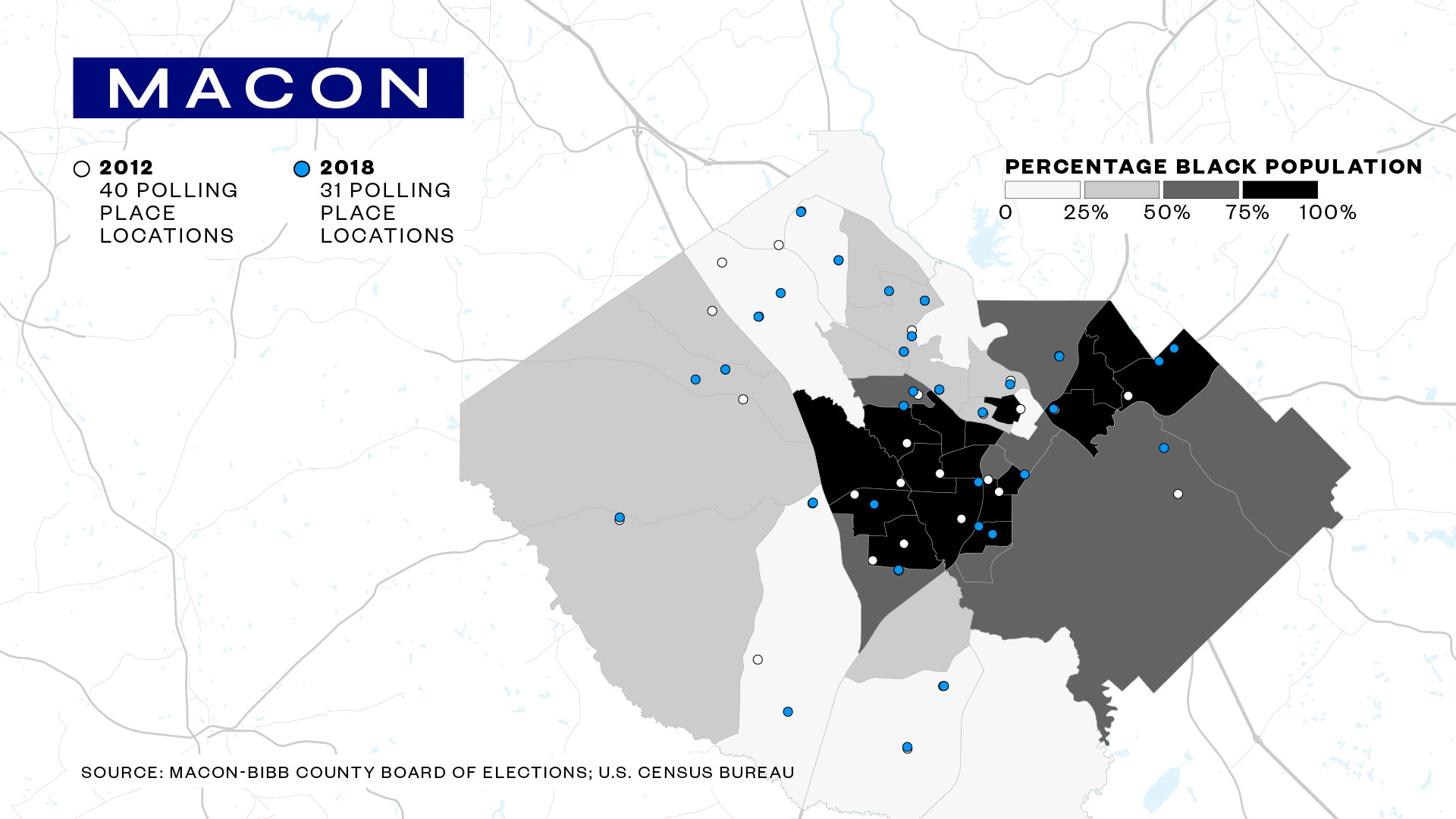 Johnisha Carswell liked voting at Agnes Barden Elementary School, one of the eight locations that closed in 2015. It was less than a mile from her home, and she could walk there with her three children. “It was easy because we was taking the kids to school and we could just stop on by and vote,” she said from her front door, watching her husband fix a flat tire.
The Carswells now vote at a church about two miles up the road, but it’s not easily accessible by public transportation. The family shares one car, which her husband Marcus Carswell usually takes to drive to work. In 2016, Johnisha got a ride from her mom to go and vote.
“I think our job is just mainly to make sure you're registered and come vote. And we can't really get into, ‘OK, you don't have a car,’” said Jeanetta Watson, the elections supervisor. Watson makes recommendations to the five-person Board of Elections, who ultimately decide when to close or consolidate polls. “We do take that [public transportation] into consideration, but I don't think there are bus lines near a lot of our polling locations.”
Johnisha Carswell liked voting at Agnes Barden Elementary School, one of the eight locations that closed in 2015. It was less than a mile from her home, and she could walk there with her three children. “It was easy because we was taking the kids to school and we could just stop on by and vote,” she said from her front door, watching her husband fix a flat tire.
The Carswells now vote at a church about two miles up the road, but it’s not easily accessible by public transportation. The family shares one car, which her husband Marcus Carswell usually takes to drive to work. In 2016, Johnisha got a ride from her mom to go and vote.
“I think our job is just mainly to make sure you're registered and come vote. And we can't really get into, ‘OK, you don't have a car,’” said Jeanetta Watson, the elections supervisor. Watson makes recommendations to the five-person Board of Elections, who ultimately decide when to close or consolidate polls. “We do take that [public transportation] into consideration, but I don't think there are bus lines near a lot of our polling locations.”
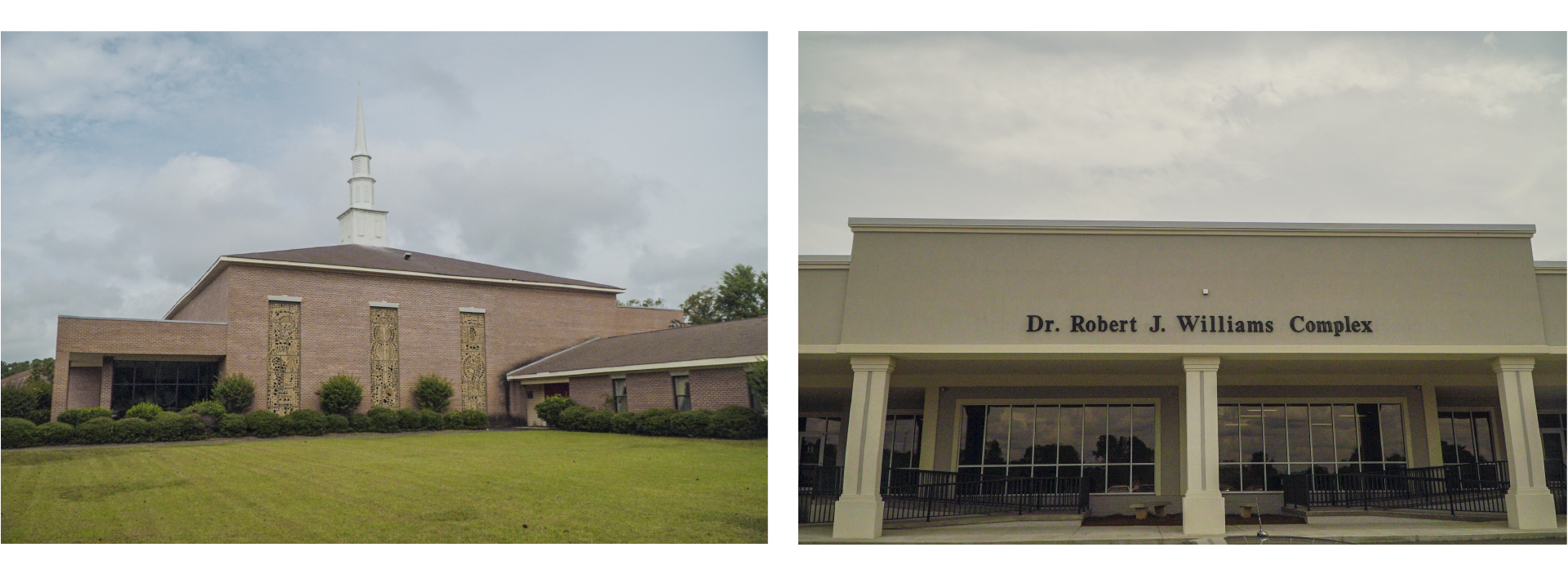 Left: The Central Church of Christ, a former polling place. Right: The Dr. Robert J. Williams Complex, the site of the new polling place. Allison McCann for VICE News.
Rolston Mondaizie, the pastor at the Central Church of Christ, remembers past Election Days fondly. “We felt privileged to host the voting precinct here, and we felt it was our obligation to the community,” said Mondaizie. “And for a number of years — probably 10 years — the community came in and voted here.” He said a few people still show up at the church each Election Day to try to vote, and that he directs them to the new location.
The polling place moved less than a mile away, to a medical complex with “more room and space,” said Watson. She said they withdrew voting at the Central Church of Christ because they often had a hard time reaching Mondaizie and getting the church open on Election Day. (Mondaizie disputes this, and said he attended the board hearings and asked to keep the poll location open at his church.)
Left: The Central Church of Christ, a former polling place. Right: The Dr. Robert J. Williams Complex, the site of the new polling place. Allison McCann for VICE News.
Rolston Mondaizie, the pastor at the Central Church of Christ, remembers past Election Days fondly. “We felt privileged to host the voting precinct here, and we felt it was our obligation to the community,” said Mondaizie. “And for a number of years — probably 10 years — the community came in and voted here.” He said a few people still show up at the church each Election Day to try to vote, and that he directs them to the new location.
The polling place moved less than a mile away, to a medical complex with “more room and space,” said Watson. She said they withdrew voting at the Central Church of Christ because they often had a hard time reaching Mondaizie and getting the church open on Election Day. (Mondaizie disputes this, and said he attended the board hearings and asked to keep the poll location open at his church.)
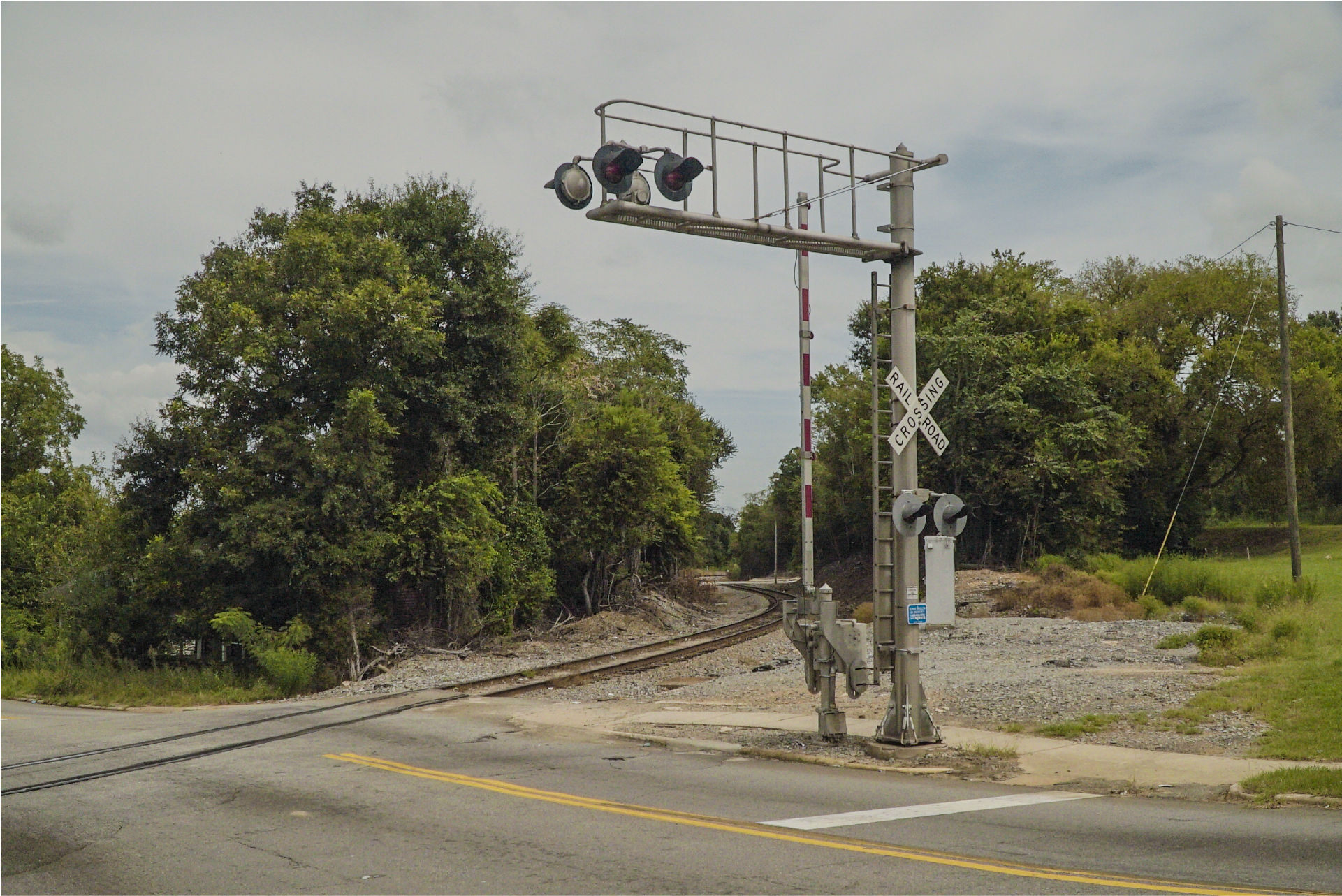 Allison McCann for VICE News.
Macon’s poll closures, like in many counties across Georgia, were done in an apparent effort to save money. Watson said the county isn’t saving the projected $44,000 per year, but she estimated it was close, “maybe 20 or 30 thousand,” depending on whether it’s a presidential or non-presidential election year.
“Government employees always want to save money and do less work, but that’s not an adequate justification for infringing on constitutional rights,” said Young. “What is the price of our democracy?”
Allison McCann for VICE News.
Macon’s poll closures, like in many counties across Georgia, were done in an apparent effort to save money. Watson said the county isn’t saving the projected $44,000 per year, but she estimated it was close, “maybe 20 or 30 thousand,” depending on whether it’s a presidential or non-presidential election year.
“Government employees always want to save money and do less work, but that’s not an adequate justification for infringing on constitutional rights,” said Young. “What is the price of our democracy?”
An outdated formula
Advertisement
 Left: Manatee County residents supporting Andrew Gillum in the August gubernatorial primary. Right: Mount Raymond Baptist Church, a polling place in Palmetto, Florida. Rob Arthur for VICE News.
Plagued by
Left: Manatee County residents supporting Andrew Gillum in the August gubernatorial primary. Right: Mount Raymond Baptist Church, a polling place in Palmetto, Florida. Rob Arthur for VICE News.
Plagued by 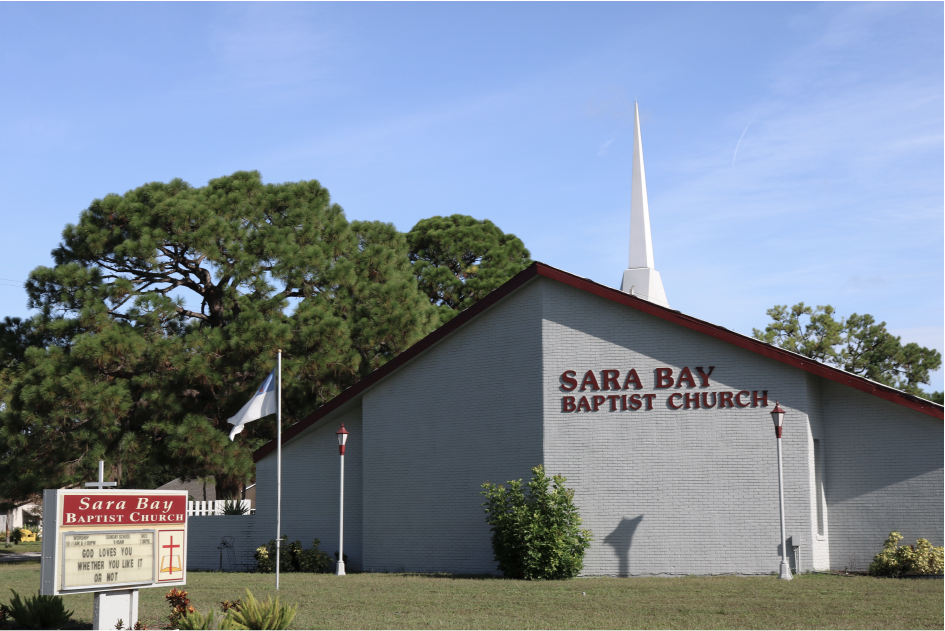 Sara Bay Baptist Church, a polling place in Manatee County. Rob Arthur for VICE News.
“Nobody [went] there,” Bennett said of the closed polling places. Asked whether he considered the racial or demographic makeup of the areas surrounding closed polling places, Bennett simply answered “No.” Money from the closures went into opening early voting locations and an aggressive vote-by-mail campaign. Bennett said that early voting tallies doubled as a result.
But
Sara Bay Baptist Church, a polling place in Manatee County. Rob Arthur for VICE News.
“Nobody [went] there,” Bennett said of the closed polling places. Asked whether he considered the racial or demographic makeup of the areas surrounding closed polling places, Bennett simply answered “No.” Money from the closures went into opening early voting locations and an aggressive vote-by-mail campaign. Bennett said that early voting tallies doubled as a result.
But 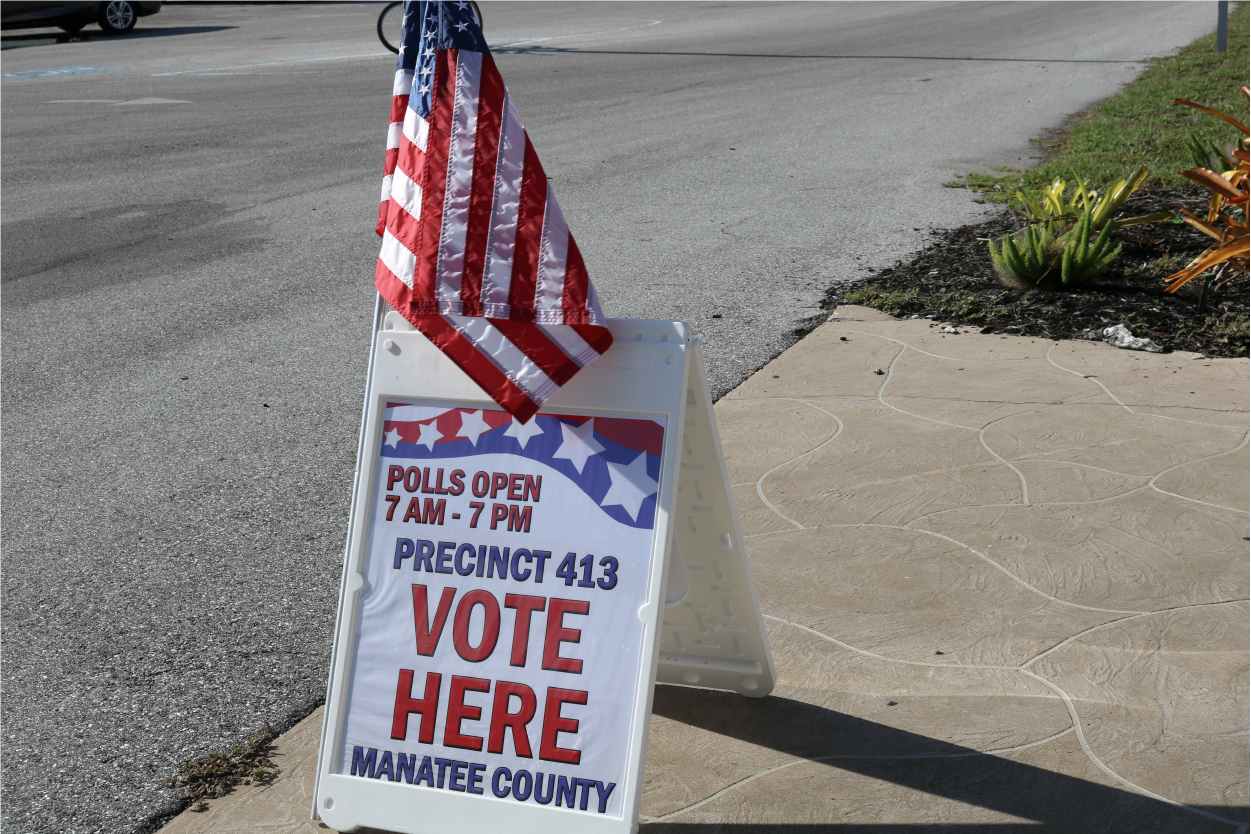 Rob Arthur for VICE News.
Jones’ own old polling place, a church within a five-minute walk, was relocated to a civic center across the railroad tracks. It’s at least a 30-minute trip on foot, and impossible to get to without a car for older voters or people with disabilities, Jones said. “We still have transportation impediments,” Jones said about people in his community, which is predominantly black.
Even when a voter tries to shift to vote-by-mail, it may not be an easy transition. About 10 percent of Manatee’s population speaks Spanish at home. Bennett, like many other local officials, has resisted printing ballots in Spanish, but civil rights organizations
Rob Arthur for VICE News.
Jones’ own old polling place, a church within a five-minute walk, was relocated to a civic center across the railroad tracks. It’s at least a 30-minute trip on foot, and impossible to get to without a car for older voters or people with disabilities, Jones said. “We still have transportation impediments,” Jones said about people in his community, which is predominantly black.
Even when a voter tries to shift to vote-by-mail, it may not be an easy transition. About 10 percent of Manatee’s population speaks Spanish at home. Bennett, like many other local officials, has resisted printing ballots in Spanish, but civil rights organizations